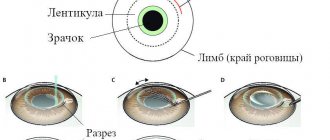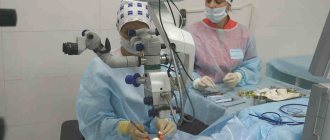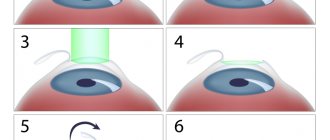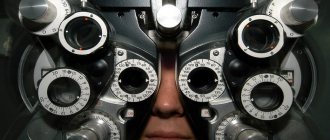Laser vision correction is an ophthalmological microsurgical operation performed to correct (correct) refractive errors. Laser correction methods are being improved year after year, new equipment is being developed, and operating technologies are changing.
Today, most specialized clinics practice four main methods of laser correction:
- LASIK
- SUPER LASIK
- FEMTO LASIK
- FEMTO SUPER LASIK
All these methods are based on a single algorithm of sequential actions:
- Performing a microsection of the upper fragment of the cornea with the formation of a certain size flap of tissue.
- Removal of a section of stroma using a laser to change the refractive power of the cornea.
- Returning the formed flap to its original place.
The result of the operation is an improvement in visual functions without the need for further wearing of correction devices.
PRK - photorefractive keratectomy (PRK - Photo Refractive keratectomy)
The essence of photorefractive keratectomy is a non-contact effect on the cornea (from the surface to the middle layers) without penetration of laser radiation into other structures of the eye. Vision correction using the PRK method was first performed in 1985. Postoperative recovery with this technique takes quite a long time and requires regular use of eye drops until the corneal tissue is completely healed. In this regard, vision correction using photorefractive keratectomy is performed in one intervention on only one eye. The second eye undergoes correction only after complete healing of the operated cornea.
The limits of application of the PRK method: myopia from -1.0 to -6.0 diopters, farsightedness up to +3.0 diopters, astigmatism from -0.5 to -3.0 diopters.
LASIK (laser keratomileusis) LASIK (Assisted in Situ Karetomileusis)
The beginning of the use of laser keratomileusis is considered to be 1989. To preserve the surface of the cornea during laser microsurgical treatment, it has been proposed to lift its outer layers and act only on tissues located at an average depth. This became possible with the help of special devices - microkeratome.
The advantages of LASIK correction are obvious:
- treatment is carried out “in one day”;
- shortened recovery period;
- possibility of performing surgery on both eyes at the same time;
- gentle effect on corneal tissue;
- Painless and well tolerated;
- Predictability of results.
The limits of application of the LASIK method are: myopia -15.0 D, myopic astigmatism -6.0 D, hyperopia +6 D, hypermetropic astigmatism +6 D.
LASIK method
Finally, an ophthalmologist will help with the choice by comprehensively assessing the patient’s condition.
LASIK (laser-assisted keratomileusis) is the most high-tech and reliable method of vision correction, known since 1990. The procedure combines surgery and laser techniques.
Using special equipment, a corneal flap is formed; after bending it, the laser acts on the deep layers of the eye. The result is a renewed corneal surface that allows images to be accurately focused on the retina.
The LASIK method is popular and effective and has the following advantages:
- safety and speed of execution;
- The operation can be performed on both eyes at once;
- short and painless recovery period;
- minimal risk of adverse reactions;
- the ability to improve vision in any pathology;
- the upper layers of the cornea are not affected;
- stability of the result for a long time.
There are also disadvantages to correction using the LASIK technique. The main disadvantages of the procedure:
- The operation is not performed for persons under the age of majority. Until the age of 18, the visual organs are not yet fully formed.
- High cost of the operation.
- Some medical contraindications and individual characteristics of the eyes.
- Vision stabilizes within several months.
- Sometimes after surgery, redness of the eyes, inflammatory diseases of the eyelids, and disruption of the structure of the retina may occur.
The LASIK correction method allows the patient to regain vision within one day, and the results of the procedure last almost a lifetime.
LASEK (Laser Epithelial Keratomileusis)
In 1999, Italian ophthalmologists proposed another modification of laser vision correction. The consonant LASEK technique is significantly different from the earlier LASIK and PRK techniques. It is applicable even in cases where the surface of the cornea is too thin and excludes the possibility of lifting the surface tissue for laser penetration into the middle layers.
LASEK is based on the temporary removal and preservation of the surface epithelium of the cornea and its further placement at the end of the operation in the same place. This procedure is more painful than LASIK and requires a long recovery, but in some cases only this method makes laser vision correction possible.
LASEK application limits: myopia up to -8 D, farsightedness up to +4 D, astigmatism up to 4 D.
Epi-LASIK (Ephithelial LASIK)
Although LASIK laser vision correction is safe and affordable for many patients, it has certain contraindications. In some such cases, it is possible to use an alternative correction technique – Epi-LASIK.
The similarity of the Epi-LASIK method with LASEK and PRK is that an epithelial flap is removed from the surface of the cornea. However, this is done using an epi-keratome, rather than using alcohol (as in LASEK) or a microkeratome with a blade (as in LASIK). As a result, the epithelium is stratified and separated into a whole flap, but much thinner than with LASIK.
Since epithelial cells retain high viability (more than 80%), their engraftment occurs faster, and the recovery period is reduced. At the end of the laser correction, the surgeon forms a perfectly smooth surface from the epithelial flap. To maintain a favorable environment, a protective contact lens is placed on the surface of the cornea. Depending on the rate of epithelial recovery, the lens is removed on the third to fifth day after surgery.
Advantages of Epi-LASIK correction:
- high rate of vision recovery after correction;
- The integrity of the cornea is preserved;
- The superficial flap is formed without incisions on the cornea;
- refraction is possible even in cases of thin cornea;
- Most of the epithelium remains viable and the flap is completely restored;
- low probability of subepithelial opacities;
- discomfort after surgery is minimal.
Epi-LASIK application limits: myopia -10 D, myopic astigmatism up to -4.0 D, hyperopia up to + 6.0 D, hypermetropic astigmatism up to +4 D.
Sign up for a consultation:
Tell us about rehabilitation after myopia correction using the Smile method.
Recovery after the procedure takes only a couple of hours. In fact, there is not even a period of lacrimation. Usually, after excimer laser operations, it takes some time (sometimes up to a month) for the normal level of eye hydration to be restored; you need to drip special drops like artificial tears. With Relex Smile this need is usually much less. In addition, there is no possibility of displacing the flap during the primary recovery period, that is, there are completely no restrictions, you can even practice boxing right away. And most importantly, visual acuity is also restored very quickly. Patients usually tell us that after 1-2 hours their vision becomes sharp.
1 vision the next day
.
They say that normal visual acuity is one. Is it possible to improve vision above one?
Here you will need an excursion into the physics of the visual apparatus. But in short, vision "one" is the maximum angle at which the normal human eye can distinguish between two points. This is due to the fact that the retina works like the matrix of a camera, so the visibility of objects depends on the distance between the pixels on the matrix or also on the concentration per unit area. The retina of the human eye is so physically saturated with these pixels that 1.0 “one” according to the test table is the norm. Although there are unique cases where some people without optics could distinguish the satellites of the planets, their visual acuity was significantly greater than one.
As for operations, when creating ideal eye optics (correcting with laser all natural irregularities of the cornea), the sharpness can become 1.2, and sometimes even 1.5.
Often after surgical vision correction, you can hear the question from patients: “Won’t my vision deteriorate anymore?” Tell me, can myopia progress again?
This possibility exists. After all, we do not change anything in the eye in any way, we just embed a contact lens inside the eye. In this case, progression of myopia (increase in eye length) is in principle possible. the eye lives its own life. It can, for example, increase. Actually, that’s why we perform vision correction operations after the age of 18, when the progression has already ended. Laser correction is preferable for stabilized myopia, but in some cases, after years, if progression has occurred, we can carry out additional correction and get excellent vision again.
Do those who have undergone Smile surgery need to be regularly checked by an ophthalmologist throughout their life?
Once a year, it is advisable to examine the fundus of the eye by a specialist. This recommendation is relevant for any person with myopia, whether he has undergone laser vision correction or not, it does not matter.
Since the myopic eye is stretched, areas of thinning and degeneration may appear on the periphery of the retina. Treating these areas with laser as needed significantly reduces the risk of any troubles with the retina.
SUPER LASIK (Super Lasik-Custom Vue)
SUPER-LASIK today is the most advanced method of laser vision correction. “Grinding” of the cornea occurs at the finest level, taking into account its most insignificant features. To carry out this type of correction, not only ultra-precise laser equipment has been developed, but also a special diagnostic complex. A unique system - the Wave Scan wavefront analyzer - allows you to track and record information about all distortions in the visual process introduced not only by the cornea, but also by other structures of the eye. Aberration analysis with this type of laser correction is an integral part of the procedure, since it forms a plan for further impact.
The possibility of the finest laser impact on the cornea makes the SUPER-LASIK technique indispensable not only for the correction of myopia, farsightedness and astigmatism, but also where higher order aberrations occur.
Patient reviews
Sergey, 33 years old, Nizhny Novgorod:
On the third day after the operation, a colleague sat at work and coded full time. I didn’t make additional corrections, I saw with both eyes, more than 1. Then everything went well for him, it turns out that the result is good. Unlike me after femtolasik, he didn’t even have red eyes or dryness.”
Ivan, 39 years old, Moscow:
Personal experience (wives) - they did it 12 years ago - one of the first experimental lasers in the then USSR. Then they made her one (it was already 10). For 12 years it fell again (a lot on the computer). They did it again 2 months ago - before the operation the wife saw only one line, after - 5 in one eye, 8 in the other. They promise that the second eye will be 8 in a couple of months, now we are waiting. Conclusion - both times it helped a lot, there is an effect. I repeat - PERSONAL EXPERIENCE - and nothing more!
Dmitry, 27 years old, Yaroslavl:
The main thing is to strictly follow the instructions after the operation and not to abuse the results obtained (do not sit at the computer for 20 hours a day, good lighting, correct mode, etc.). Now I'm just happy that I can see well. “Additional correction” had to be done on the left eye. The procedure is not pleasant, of course, but I wouldn’t go under the knife a second time if I didn’t see the point in it - I’m essentially a very practical person.
Roman Vasilievich, 43 years old. Saint Petersburg:
I can’t say anything good or anything bad. Initially, there were problems since childhood and in the end there was 0.01%, that is, -10 + astigmatism. We did it for the first time, at first the result was excellent (they promised 0.7 - 0.8, and that’s what happened the first time - this is the best thing I’ve seen in the most excellent glasses), then it dropped to -2, -2.5. I came a second time, so to speak, “under warranty.” There were a lot of people like me, about 20 people, however, as I was told, they were collected in a few months. Now, if you try not to sit at the monitor for a long time, do exercises, then your vision is 1, in circles I see 0.8-0.9 due to astigmatism. I don’t have 100% vision and never have, but I’m very pleased. There are no halos, judging by reviews from various forums, no one is immune from halos, this is the fate of about 25% of those who have had surgery. In the dark, my vision is a little blurry, but if there is light from some light bulbs, then everything is visible perfectly. I drive either during the day or at night without any problems. Yesterday I just had a medical examination (a year and a half since the repeat operation) - everything is good, the same almost 1 in letters and 0.8-0.9 in circles. There are no contraindications after the operation, I drank, went to the sauna, went to the gym, and went to the pool. If it weren't for the operation, I wouldn't have seen my license.
FEMTO-LASIK
The FEMTO-LASIK technique is also called Intra-LASIK or “all laser LASIK” (All Laser Lasik). This type of laser vision correction is characterized by the complete abandonment of a mechanical microkeratome with a steel blade. During the procedure, a corneal flap is also formed using laser exposure - a femtosecond laser.
This excimer laser correction technique was first used in 2003 and has now proven its high efficiency and safety.
Benefits of laser vision correction
In world medical practice, a huge number of operations are performed annually. The effectiveness of laser correction and its safety have been proven by long-term observations of patients. Among the main advantages of laser technology are the following:
- laser technique can be used for any type of refractive error, if there are no contraindications;
- high speed of surgical intervention;
- laser correction does not cause pain to the patient;
- the patient does not need to go to the hospital, the entire procedure takes a minimum amount of time;
- rapid restoration of visual function allows you to feel improved vision within a couple of hours after the procedure;
- predictability of results is ensured by accurate computer data processing;
- the correction results are stable.
The speed of restoration of visual functions, patient tolerance of the effect and durability of the result are the main indicators that determine the popularity of laser vision correction today.











